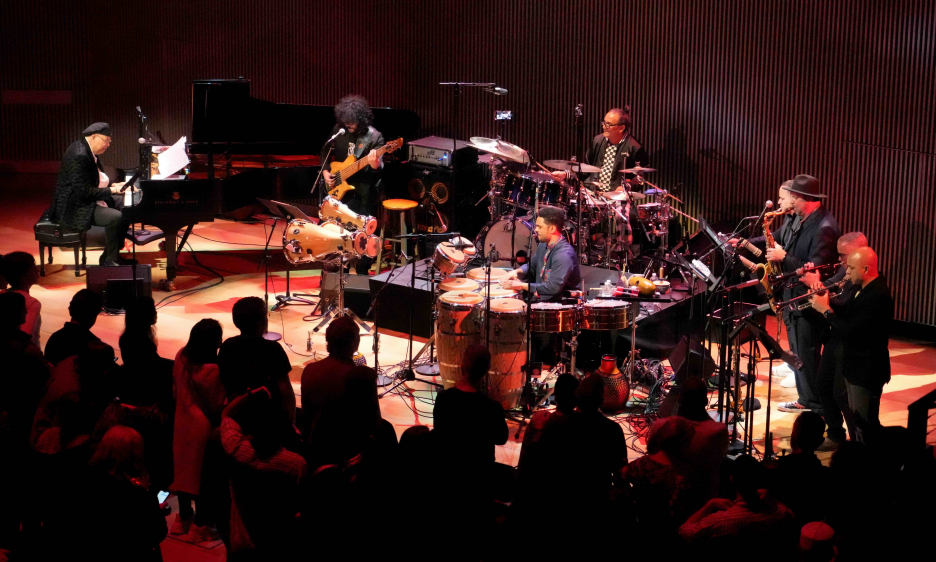Home » Jazz Articles » Live Review » Irakere 50 at SFJAZZ Center
Irakere 50 at SFJAZZ Center

Courtesy Rick Swig
SFJAZZ Center
San Francisco, California
February 15, 2024
On April 25, 1973, the Santiago de Cuba stadium saw a historic event when Irakere (an eight-member band whose name means "forest" in Yoruba) debuted. Attendees had never experienced anything quite like it before. The musicians, all originally members of the eclectic Orquesta Cuba de Música Moderna, blended jazz, classical, Cuban pop, Afro-Cuban folkloric and funk music in an unparalleled mix. Two of the musicians—pianist and musical director pianist Chucho Valdes and assistant musical director saxophonist Paquito D'Rivera—went on to establish themselves as musical legends, as did trumpeter Arturo Sandoval who would join later. The lesser known late flutist José Luis Cortés who founded NG La Banda (which launched the wildly popular timba movement) was equally influential if not as famous.
Irakere was fortunate to land under the tutelage of Dave Brubeck, who helped open some doors and, the next thing they knew, the band was an international sensation. Irakere went on to win a Grammy (in 1997 for their eponymous debut recording) and has had a transformative impact on Cuban music, Latin jazz, and salsa, and over the years the group has gone through various versions and permutations.
Now an accomplished master of the acoustic piano, one whose playing has an elegant veneer and a regal feel to it, Valdés grew up in the shadow of his father Bebo, a renowned pianist. While he has performed solo and with his Afro-Cuban Jazz Messengers, Valdés has periodically created new versions of Irakere to commemorate anniversaries. For Irakere 50, Valdés assembled eight master musicians and a vocalist for a series of shows at the SFJAZZ Center in San Francisco. The inclusion of drummer Horacio "El Negro" Hernandez, an accomplished musician who has played with the likes of Chico O'Farrill, Gary Bartz and Steve Turre, stood out.
A vigorous Valdés, who called the tunes and introduced them in Spanish, conducted the nine virtuoso instrumentalists through the first seven numbers. The classic "Juana Mil Ciento" led off when Roberto Vizcaíno played a dynamic batá drum solo as an introduction. "Zanaith" began with a soprano sax solo from Luis Beltran. "Yansa," another Valdés classic, followed and was introduced by a piano solo. Jose Armando Gola soloed on bass while Beltran soloed on alto and Vizcaino blazed on bongos. "Lorena's Tango" had a bit of a classical feel to it before the bass and drums came in before Carlos Fernandez soloed on tenor.
"Congadanza"—a composition celebrating the life of María Cervantes, daughter of the Cuban composer and pianist Ignacio Cervantes—combined the traditional contradanza with the enthusiasm of the congo as present in Carnaval. Hernández played with his stick and hands and then with his hands. Fernandez soloed again on tenor before Valdés came in strongly on the keys.
After an hour in, it was time to cater to the dance floor to the front of the stage as vocalist Ramon Martinez took center stage for more danceable portion of the evening, one which featured such staples as "Iya," "Por Romper el Coco," "Lo Que Va a Pasar" and, finally, "Xiomara," a funky rumba tune with jazz elements.
The band returned to its roots to encore and sweep the audience away with a spirited Valdés' "Bacalao con Pan," its first (1972) hit. Based on a traditional pregon, a street vendor's cry, "Bacalao con Pan" was the first Cuban tune to employ the Santeria ritual-based batá drums. It resonated with the public because dried codfish and bread were all that people could afford at the time. And it was also a hit with that night's audience. Exhorted to dance by a gesturing Valdés, they enthusiastically participated as the energetic evening of music drew to a close.
Tags
Live Review
Harry S. Pariser
United States
California
san francisco
Irakere
Orquesta Cuba de Música Moderna
Chucho Valdes
Pacquito D'Riviera
arturo sandoval
José Luis Cortés
NG La Banda
Dave Brubeck
Horacio El Negro Hernández
Chico O'Farrill
Garry Bartz
Steve Turre
Roberto Vizcaíno
Jose Armando Gola
Carlos Fernandez
PREVIOUS / NEXT
Support All About Jazz
 All About Jazz has been a pillar of jazz since 1995, championing it as an art form and, more importantly, supporting the musicians who make it. Our enduring commitment has made "AAJ" one of the most culturally important websites of its kind, read by hundreds of thousands of fans, musicians and industry figures every month.
All About Jazz has been a pillar of jazz since 1995, championing it as an art form and, more importantly, supporting the musicians who make it. Our enduring commitment has made "AAJ" one of the most culturally important websites of its kind, read by hundreds of thousands of fans, musicians and industry figures every month.





























